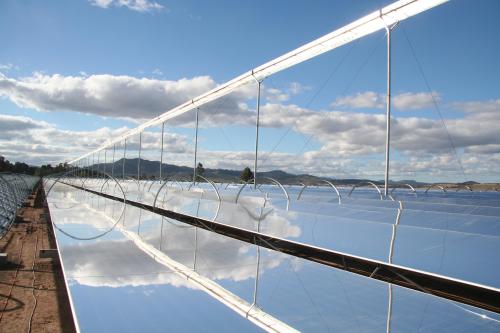photo: Todd Woody
In Thursday’s New York Times, I write about how the nascent solar thermal boom in California’s Mojave Desert is being derailed by lawsuits from environmental, union and Native American groups:
SAN FRANCISCO — Just weeks after regulators approved the last of nine multibillion-dollar solar thermal power plants to be built in the Southern California desert, a storm of lawsuits and the resurgence of an older solar technology are clouding the future of the nascent industry.
The litigation, which seeks to block construction of five of the solar thermal projects, underscores the growing risks of building large-scale renewable energy plants in environmentally delicate areas. On Jan. 25, for instance, Solar Millennium withdrew its 16-month-old license application for a 250-megawatt solar station called Ridgecrest, citing regulators’ concerns over the project’s impact on the Mohave ground squirrel.
At peak output, the five licensed solar thermal projects being challenged would power more than two million homes, create thousands of construction jobs and help the state meet aggressive renewable energy mandates. The projects are backed by California’s biggest utilities, top state officials and the Obama administration.
But conservation, labor and American Indian groups are challenging the projects on environmental grounds. The lawsuits, coupled with a broad plunge in prices for energy from competing power sources, threaten the ability of developers to secure expiring federal loan guarantees and private financing to establish the projects. Only one developer so far, BrightSource Energy, has obtained a loan guarantee and begun construction.
Like so many of this state’s troubles, the industry’s problems are rooted in real estate.
After President George W. Bush ordered public lands to be opened to renewable energy development and California passed a law in 2006 to reduce carbon emissions, scores of developers staked lease claims on nearly a million acres of Mojave Desert land. The government-owned land offered affordable, wide-open spaces and the abundant sunshine needed by solar thermal plants, which use huge arrays of mirrors to heat liquids to create steam that drives electricity-generating turbines.
But many of the areas planned for solar development — including the five projects being challenged — are in fragile landscapes and are home to desert tortoises, bighorn sheep and other protected flora and fauna. The government sped through some of the required environmental reviews, and opponents are challenging those reviews as inadequate.
“There’s no good reason to go into these pristine wilderness areas and build huge solar farms, and less reason for the taxpayers to be subsidizing it,” said Cory J. Briggs, a lawyer representing an American Indian group that has sued the United States Interior Department and the Bureau of Land Management to stop five of the solar thermal plants. “The impacts to Native American culture and the environment are extraordinary.”
The risk that the suits will succeed in blocking construction could make it more difficult for the builders to get federal loan guarantees or attract private financing.
Officials with the Loan Programs Office of the United States Energy Department did not respond to requests for comment. However, department guidelines classify litigation risk as a significant factor to be considered when qualifying renewable energy projects for a loan guarantee.
Brett Prior, a solar analyst with the GTM Research firm, said commercial lenders also viewed the suits as a negative. “In general, there are more projects chasing project finance than there are funds available, so the investment banks can be selective when deciding which projects to support,” he said. “Projects with lawsuits pending will likely move to the back of the queue.”
The conflict over the California projects has already accelerated a shakeout among competing solar technologies.
Tessera Solar announced last week that it had sold its 709-megawatt Imperial Valley solar dish project, which had become the target of two lawsuits. The buyer, AES Solar, develops power plants using photovoltaic panels like those found on residential rooftops. The move follows Tessera’s sale of its 663.5-megawatt Calico solar dish power plant in late December, a week after the company lost its longstanding contract with a utility. Calico is the subject of three lawsuits, and the project’s new owner, a New York firm called K Road Power, said it planned to abandon most of the Tessera solar dishes and instead use photovoltaic panels.
You can read the rest of the story here.





